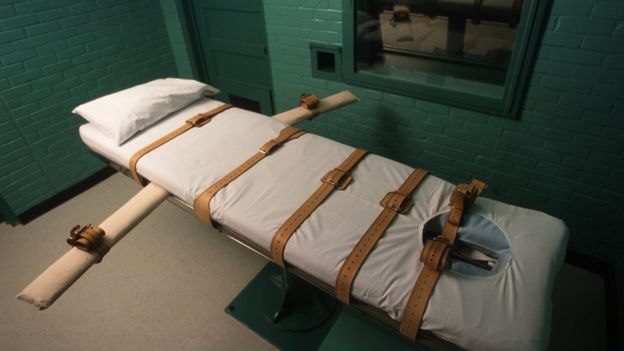US government orders first federal executions since 2003

The US federal government is to resume executing death-row inmates after a 16-year hiatus, the justice department has announced.
Attorney General William Barr said in a statement he had directed the Bureau of Prisons (BOP) to schedule the executions of five inmates.
Mr Barr said the five had been convicted of murders or rapes of children or the elderly.
The executions have been scheduled for December 2019 and January 2020.
"Under administrations of both parties, the Department of Justice has sought the death penalty against the worst criminals," Mr Barr said in a statement. "The Justice Department upholds the rule of law - and we owe it to the victims and their families to carry forward the sentence imposed by our justice system."
Rights groups say they are concerned that the executions have been scheduled so close together. Casey Stubbs from the American Civil Liberties Union (ACLU) said it raised "serious questions about the fairness for each of those cases".
"We need time to consider and review cases and there's just absolutely no basis for lumping cases together in this way and rushing forward," she said.
Mr Barr's announcement lifts what was an informal moratorium on the federal death penalty - as opposed to state-directed executions - since the 2003 execution of Louis Jones Jr, a 53-year-old a Gulf War veteran who murdered 19-year-old soldier Tracie Joy McBride.
Under the US justice system, crimes can be tried either in federal courts - at a national level - or or state courts, at a regional level. Certain crimes that apply nationally, such as counterfeiting currency or mail theft, are automatically tried at a federal level, while others are tried in federal courts based on the severity of the crimes.
The death penalty was outlawed at state and federal level by a 1972 Supreme Court decision that cancelled all existing death penalty statutes. A 1976 Supreme Court decision reinstated the death penalty to a number of states and in 1988 the government passed legislation that made the death penalty available again at a federal level.
According to data collected by the Death Penalty Information Center, 78 people were sentenced to death in federal cases between 1988 and 2018 but only three have since been executed. There are 62 inmates currently on federal death row.
Mr Barr is to allow the prison authorities to use the single drug Pentobarbital in place of a three-drug procedure previously used in federal executions. The drug is a potent sedative that slows down the body, including the nervous system, to the point of death.
The five executions to be scheduled would take place at the US Penitentiary at Terre Haute, Indiana, and additional executions would take place at a later date, the justice department said.
For more than a decade and a half, the federal death penalty was mostly an afterthought. Although there was no formal moratorium on the procedure, as there was in some states where opposition to executions has been growing, a combination of administrative inertia, protracted appeals processes, practical obstacles and the relatively few number of federal death-row inmates combined to grind executions to a de-facto halt.
The Trump administration now wants to change that, even if a shortage of the drugs used in lethal injections remains a significant obstacle.
The president has expressed a harsh attitude toward convicted criminals in the past, claiming that they are treated too gently and given too many opportunities to appeal against their sentences.
While a majority of Americans say they still favour the death penalty in certain instances, opinion surveys indicate that the American public is turning against capital punishment, with a particular eye toward allegations that it is frequently unjustly imposed.
That suggests that while the Trump administration's announcement will draw some sharp criticism from activists, it is unlikely to cause significant political waves.
